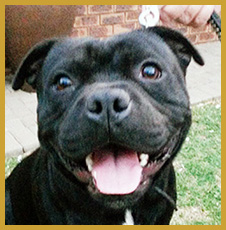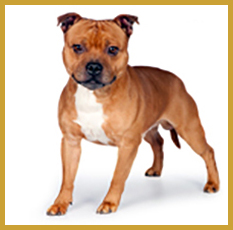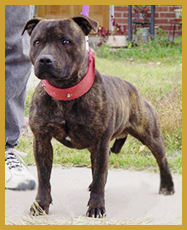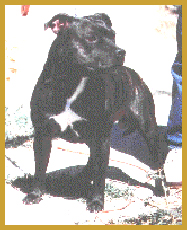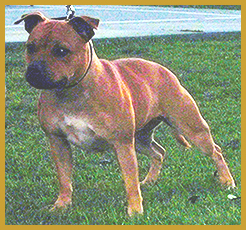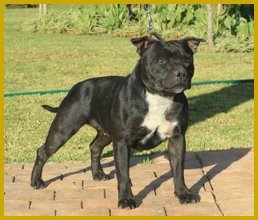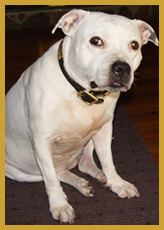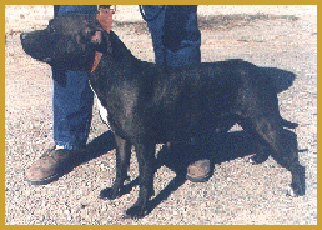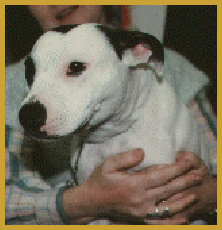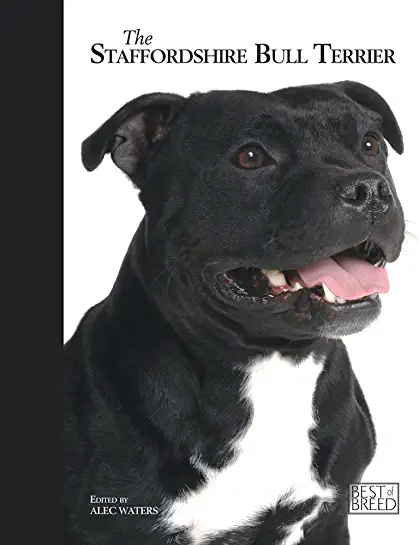Article 7
The head of the Staffordshire Bull Terrier
by Alec Waters
The Staffordshire Bull Terrier Breed Standard is, as breed standards go, a reasonably comprehensive and descriptive one. It was composed and written by a small group of gentlemen in a Black Country public house, the Crossed Guns, around 1935. These men were far sighted and enthusiastic to see the Stafford take his place in the show ring along with the Bull Terrier and all the other various terriers. They saw the potential in a breed that was originally bred for an entirely different kind of activity, and a so called sport. Although dog fighting had been made illegal by Parliament many years before, the practice still continued albeit in secret and underground. It is interesting to note that there are still people today who clearly state that the Stafford is not a show dog. Since the first or the original breed standard was written, it has been amended on two separate occasions by the Kennel Club, (show own all of the breed standards) firstly in 1948 and again in 1986, although none of those alterations affected the clause which describes the head. Although I have stated that our breed standard is reasonably comprehensive, and describes most points fairly well, if one was given the task of improving(?) it, or whatever, it would be very tempting for most of us to make a few alterations, amendments additions etc. etc. to our breed standard!
Without a doubt the more descriptive, and lengthy a breed standard becomes, the more complicated it will be, and more important it will prove very difficult (or even impossible) to find a specimen that would fit this more descriptive and lengthy breed standard! In my view, however, there is one clause in our breed standard which I believe could be improved, or made clearer, and possibly avoid confusion and uncertainty, and I refer to the head clause which reads thus... short, deep through with broad skull. Very pronounced cheek muscles, distinct stop...
Now as we have all seen (those who are familiar with the Staffordshire Bull Terrier) head types, shapes can differ very considerably in this breed, we can see different styles of skulls (domed, flat, and rounded etc.). Forefaces, eye shapes eye positions and so on. The various descriptions of all the different kinds of heads could fill a great number of pages, but to attempt to simplify the matter, I propose to divide the various types of heads into three groups (all based on a 9 inch head length).
- ONE... The head that has longer than average length of muzzle or foreface, say five parts skull to four parts foreface, or measuring (approximately) 5 inches from occiput to stop, and 4 inches stop to nose.
- TWO... The head, which I believe to be the correct ration 2/3rd to 1/3rd or measuring (approximately) 6 inches occiput to stop and 3 inches stop to nose.
- THREE... The head with an extremely short foreface, say 7 parts to 2 part. Or 7 inches from occiput to stop and 2 inches stop to nose, this type of head is quite popular with many fanciers.
Of course all of these measurements are all approximately and will vary a 1/2 inch or more either way. Taking the first example, 5 parts skull and 4 parts foreface this type of head was a more common sight 25 years ago or so, it usually had a more shallow skull and not such a defined stop as you would see on examples 1 and 2. The eyes were not usually wide enough apart which often gave a foreign expression. This type of head still occasionally appears, but of course is not very popular. There can be no doubt that the concentration and improvement (?) on heads over the last 20 or so years has eliminated this longer type of foreface... and of course it is very easy to spot in the whelping box!
The second example, the 2/3rd skull to 1/3rd foreface, which to me, and many other people seems to be the ideal balanced head, and generally a head of these proportions can usually breath quite comfortably (except of course where dogs have a soft pallet, but that unfortunate condition is a matter for a different article and can only be written by a veterinary surgeon) and we must remember that this condition can appear in any type of head. The 2/3rd to 1/3rd would usually have a deep (through?) skull, a distinct stop, and a reasonable width between the eyes.
Our third example, the shorter forefaced head, roughly 7 parts skull to 2 parts foreface or 7 inches occiput to stop and only 2 inches stop to nose (approximately) will be almost certain to have a very deep (through?) skull often rounded. These type of heads with the shorter foreface can experience breathing difficulties ( particularly in very hot weather). They also can tend to have smaller teeth than the first two examples. There can be no doubt though, the shorter foreface can look very impressive, and quite popular amongst many fanciers The admirers of this type of head will tell you, quite reasonably, that the head clause in our BREED STANDARD clearly states, and I quote SHORT DEEP THROUGH, WITH BROAD SKULL, DISTINCT STOP AND SHORT FOREFACE. This very clear statement raises the old age question, how deep is deep and how short is short?
In my view, and I base my view on a theory in this matter, because I believe that the original authors of our BREED STANDARD (our gentlemen in that BLACK COUNTRY public house), when writing it were most popular terriers of that particular time, and of course I am referring to the Airedale Terrier and the Smooth and Wire Fox Terriers all had (and of course still have) a comparatively shallow and narrow skull, (certainly not deep through!), and most important to my theory, a fairly long foreface, I feel, therefore, that the terms used DEEP THROUGHOUT were elaborately used to make a clear distinction between those sort TERRIER HEADS and the head of the STAFFORD. To attempt to make my point a little clearer, a typical SMOOTH or WIRE FOX TERRIER would have approximately almost equal proportions of skull and foreface, or 4 inches occiput to eye and 4 inches eye to nose. These measurements are based on the proportions of a SMOOTH FOX TERRIER in my kennels. It would, therefore, be a reasonable assumption to make that the term SHORT FOREFACE would have to mean SHORTER than a skull and foreface of equal proportions, so that it could be seen how a STAFFORDSHIRE BULL TERRIER head of, say 2/3rd skull and 1/3rd foreface proportions could quite accurately be described as in our breed standard as short foreface, and even in the longer foreface of the 5 inch skull to the 4 inch head! After attempting to describe the three types of Stafford heads, there are still a number other styles and shapes of heads in our breed, and it would be impossible to describe the head in every conceivable detail in the BREED STANDARD, to attempt to eventually make all the heads in our breed totally similar! We could however, clearly describe the IDEAL proportions of the head (skull and foreface) so there could be no disagreement or doubts as to what the breed standard required, no arguments as to what the correct proportions should be, it may also settle the questions of how short is short!
So therefore, my own solution in this matter would be to insert the BE in the head clause.
I have deliberately left out the key words. To (hopefully!) promote argument and constructive argument! As I have already, stated my own preference in the matter, I strongly lean towards 2/3rd. skull and 1/3rd. foreface, and although the very short foreface can look impressive , we must be on our guard against exaggerations most importantly not to loose sight of the original concept of the shape and purpose of this breed I.E. A FIGHTING TERRIER. Unrestricted breathing and stamina are essential, which should be found in the 2/3rd., to 1/3rd. ration head, but not always found in the very short foreface. Whatever we agree are the ideal proportions of the skull and foreface, it is of paramount importance that we can easily recognize the true typical STAFFORD expression, which can only be seen if the following essentials are present, the DARK MEDIUM SIZED ROUND EYE, SET IN THE CORRECT POSITION, LOOKING AHEAD, A DISTINCT STOP, CLEAN LIP, AND A (REASONABLY) STRONG UNDERJAW (STRANGELY THE DESCRIPTION OF THE UNDERJAW IS NOT REFERRED TO IN THE HEAD CLAUSE, BUT IS INCLUDED IN THE MOUTH CLAUSE, AND SIMPLY STATES JAWS STRONG). This expression is unique, and essential, because without it there can be no true type and the head would carry a foreign expression. I have no wish to make any changes in our breed STANDARD but I feel that a description of the IDEAL proportions of head and skull included in the breed standard would greatly benefit our wonderful breed.
ALEC WATERS
